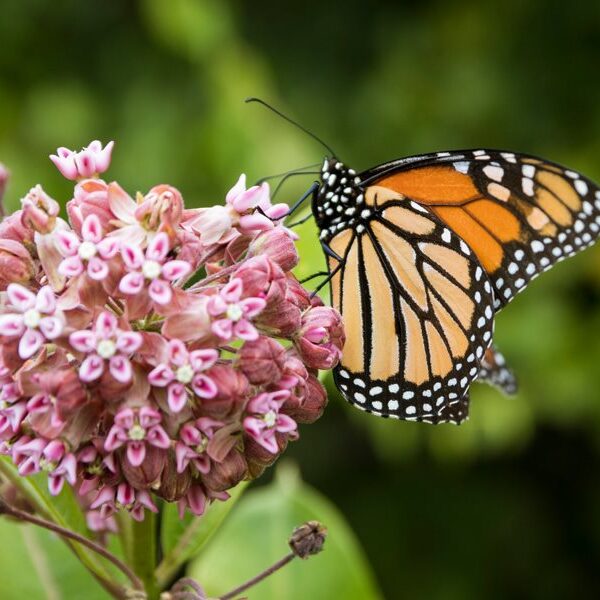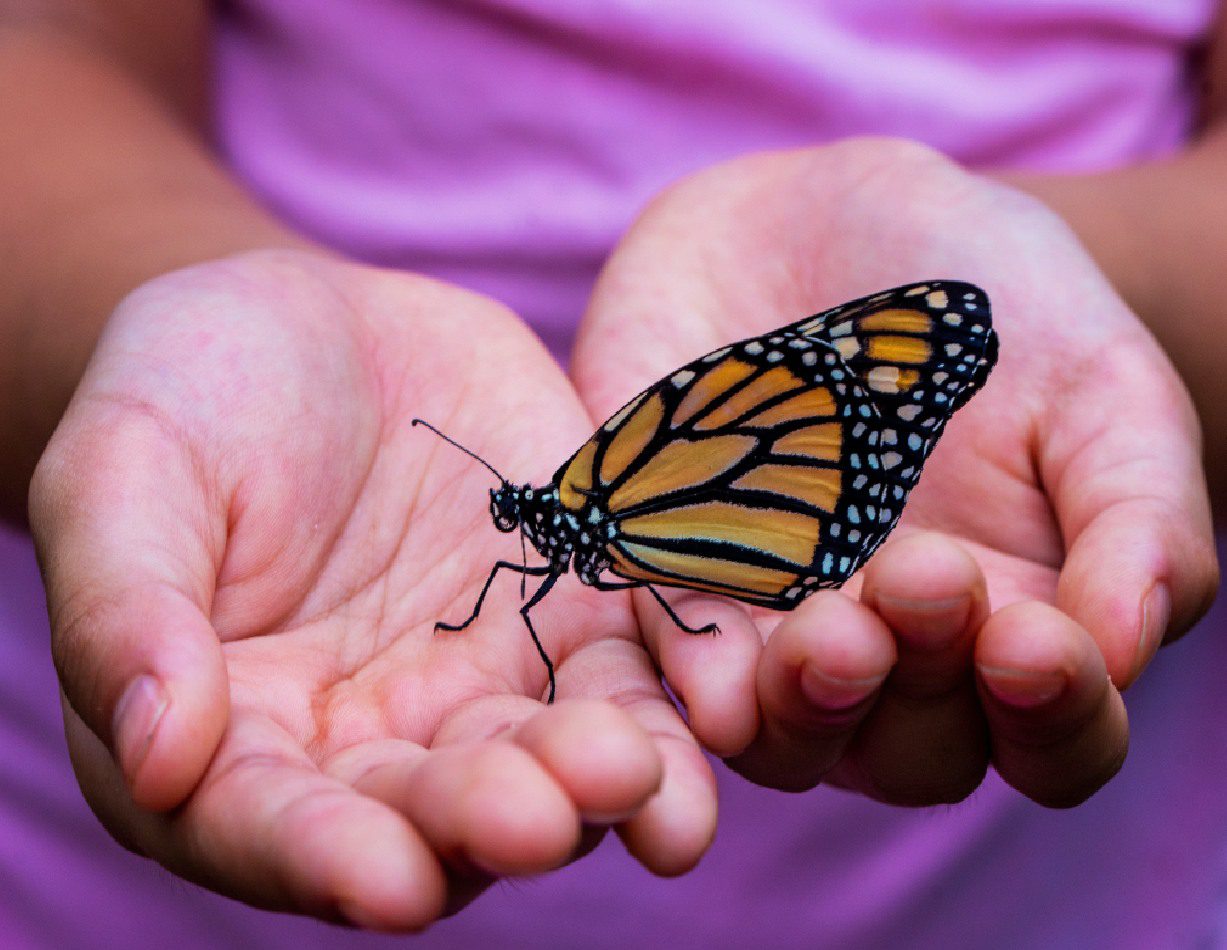
What’s So Special About Milkweed?
While many species of butterflies have specific host plants they need to raise their young (you can see a list of other butterfly host plants here), no butterfly is more precious to our collective psyche than the monarch. Monarch populations have dropped dramatically in the past few decades, and more and more home gardeners want to help by including the monarch butterfly host plant in their garden.
Monarchs co-evolved with milkweeds, and as they did, these butterflies developed a unique adaptation that allows their caterpillars to feed on a plant that many other insects cannot. You see, the latex-based sap produced by milkweed plants contains toxic compounds called cardenolides. Most other insects, save for a handful of species, can’t digest these toxins; it kills them, or they avoid it altogether due to its foul taste. But monarch caterpillars actually absorb these toxins as they feed on milkweed leaves, rendering the caterpillars themselves toxic to potential predators. The toxins found in the monarch butterfly host plant actually help protect the caterpillars and adult butterflies from birds and other predators.
Monarch Butterfly Host Plant Species
Despite milkweed’s status as the only monarch butterfly host plant, there are many different species of milkweeds that monarchs can use to raise their young. While some species have been found to be preferred over others, all members of the genus Asclepias can be used as a monarch butterfly host plant.
When planting milkweed in your garden, it’s important to choose a species of milkweed that’s native to your region whenever possible. Thankfully, there are several milkweed species that have a broad native range and are suitable for planting across much of North America. As we dive into the following list of my favorite varieties of perennial milkweed, know that these particular species are good for most parts of the continent. I am not including the annual known as tropical milkweed (Asclepias curassavica) on my list because it is a plant that’s much debated. There’s evidence that it negatively impacts monarch health and migration in some parts of the country. Plus, it isn’t perennial, nor is it native to the U.S. or Canada.

6 Favorite Perennial Milkweed Species for Monarch Butterflies:
Swamp Milkweed (Asclepias incarnata)
Don’t let the common name of this milkweed fool you. Just because “swamp” is in the name doesn’t mean this species of milkweed requires wet conditions. In fact, swamp milkweed does grow in saturated soils, but it also grows just fine in well-drained garden soil. It’s clump-forming, so unlike some other milkweed species, it doesn’t take over the garden with spreading roots (common milkweed, I’m talking about you!). I have many clumps of swamp milkweed in my Pennsylvania garden, and I’ve found it to be the easiest species to grow (see the section at the end of this article for info on how to grow milkweeds from seed). Plant this monarch butterfly host plant in full to part sun. It grows about four feet tall and is hardy in zones 3 to 7. You can buy seeds of swamp milkweed here.
Common Milkweed (Asclepias syriaca)
Common milkweed was once a ubiquitous roadside weed, but with the increased use of herbicides, it’s not so common anymore. The large, round globes of common milkweed flowers are a favorite of many pollinators, and its broad leaves always play host to many monarch caterpillars in my own backyard. But this plant comes with a warning: It is an extremely aggressive spreader, forming large colonies that spread not just by seed but also by underground roots called rhizomes. You’ll want to give common milkweed plenty of room. It’s hardy from zones 3-9 and reaches up to 6 feet in height. You can buy seeds of common milkweed here.
Purple Milkweed (Asclepias purpurascens)
My favorite species of monarch butterfly host plant, purple milkweed, is hard to find in the nursery trade but oh so beautiful! With a form similar to common milkweed, purple milkweed is a stand-out primarily due to the color of its flowers. Best described as brilliant pink, the blooms of this species of monarch butterfly host plant are absolutely stunning. In the summer, the flowers are alive with many different pollinators, including many native bees. It also spreads by rhizomes, but not quite as aggressively as common milkweed. It’s somewhat difficult to start from seed (see below) but is fully winter hardy in zones 3-8. Seeds can be difficult to find in the trade, so try to find a friend who grows this species and is willing to share seeds.
Butterfly Weed (Asclepias tuberosa)
Unlike most other milkweeds, the flowers of butterfly weed are not pink, purple, or white. Instead, this milkweed species has flowers that are bright orange. Its short stature and clump-forming habit make it the perfect fit for most gardens. Though butterfly weed isn’t typically the first milkweed chosen for monarch egg-laying, it’s definitely worth growing. Butterfly weed doesn’t like to be transplanted, so starting from seed may prove more fruitful, though it can take years for a plant to go from seed to flower. Hardy in zones 3-9 and reaching just 2 feet in height, the jazzy orange flowers of butterfly weed are nothing short of spectacular.
You can buy seeds of butterfly weed here.
Showy Milkweed (Asclepias speciosa)
Far less aggressive than common milkweed, showy milkweed is an excellent alternative. Hardy in zones 3-9 and reaching about 4 to 5 feet tall, the flower clusters of showy milkweeds look like groups of pointed stars. Though there are fewer flowers per cluster than with common milkweed, this monarch butterfly host plant species steals the show with its spiky, pink-purple blooms. Showy is a great name for it! You can buy seeds of showy milkweed here.
Whorled Milkweed (Asclepias verticillata)
The slender, needle-like leaves of this monarch butterfly host plant don’t look like many other milkweeds out there. The plant has a soft, feathery appearance, and since it tops out at about 3 feet in height, it makes a great addition to a perennial border. Whorled milkweed is not an aggressive grower, but it does spread via underground rhizomes, so be prepared to give it lots of room. The flowers of this species are a soft white with just a hint of pink at their centers. Small clusters of flowers top nearly every stem, and despite the delicate appearance of this milkweed species, it can feed a lot of monarch caterpillars. You can buy seeds of whorled milkweed here.
There are, of course, many regional species of milkweed as well. We recommend the book The Monarch: Saving Our Most-Loved Butterfly by Kylee Baumle for a complete list of over 70 native milkweed species and their geographical ranges.
Related post: A Wildlife Garden Project for All Seasons